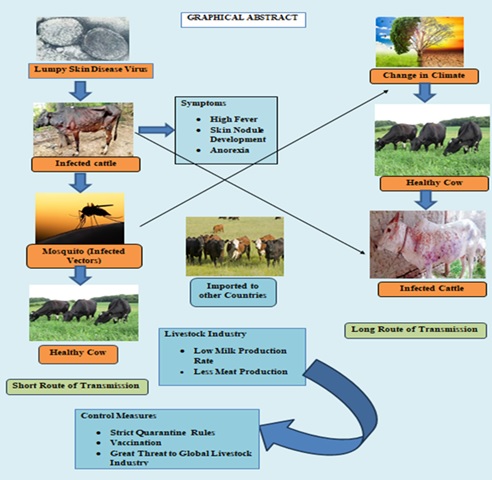Lumpy Skin Disease: An Emerging Concern in Pakistan and its Impact on National Economic Loss
Abstract
 Abstract Views: 0
Abstract Views: 0
Lumpy Skin Disease (LSD), an emerging viral infection of cattle and buffalo, poses significant challenges to the livestock industry in Pakistan. Symptoms of this disease include enlarged appearance of lumps, high fever, discharge from the eyes and nose, and loss of appetite. The incubation period of this virus in cattle is approximately 28 days, as per the report of the Food and Agriculture Organization (FAO). This viral infection spreads through direct contact among herds. The World Organization for Animal Health (WOAH) and the FAO both warn that the spread of illnesses could lead to serious economic losses. A considerable financial loss in this industry is due to the mortality rate, reduced milk and meat production rate, and increasing management and treatment expenses. Generally, the best administrative approach to treating this disease is vaccination, which is also an economically effective strategy. This review aims to provide insights into the symptoms, risk factors, control, and disease administrative strategies, economic loss associated with Lumpy Skin Disease, and the potential role of vaccination in future disease management strategies.
Downloads
References
Sprygin A, Babin Y, Pestova Y, et al. Analysis and insights into recombination signals in lumpy skin disease virus recovered in the field. PLOS ONE. 2018;13(12):e0207480. https://doi.org/10.1371/journal.pone.0207480
Elhaig MM, Selim A, Mahmoud M. Lumpy skin disease in cattle: Frequency of occurrence in a dairy farm and a preliminary assessment of its possible impact on Egyptian buffaloes. Onderstepoort J Vet Res. 2017;84(1):e1-–e6. https://pubmed. ncbi.nlm.nih.gov/28397517/
Imran MH, Khalique F, Iqbal M. Lumpy skin disease emerging problem in pakistan. 2022:1–7. https://doi.org/ 10.21203/rs.3.rs-1904208/v1
Tuppurainen ES, Stoltsz WH, Troskie M, et al. A potential role for Ixodid (hard) tick vectors in the transmission of lumpy skin disease virus in cattle. Transbound Emerg Dis. 2012;58(2):93–104. https://doi.org/ 10.1111/j.1865-1682.2010.01184.x
88th General Session World Organization for Animal Health. OIE Seventh Strategic Plan for the Period 2021–2025. https://reliefweb. int/report/world/oie-seventh-strategic-plan-period-2021-2025. Accessed May 24, 2021.
Şevik M, Doğan M. Epidemiological and molecular studies on lumpy skin disease outbreaks in Turkey during 2014-2015. Transbound Emerg Dis. 2017;64(4):1268–1279. https://doi. org/10.1111/tbed.12501
Ullah N, Basheer I, Rehman FU, et al. Livestock depredation by large carnivores and human-wildlife conflict in two districts of Balochistan Province, Pakistan. Animals .2024;14(7):e1104. https://doi.org/ 10.3390/ani14071104
Abutarbush SM. Lumpy skin disease (Knopvelsiekte, PseudoUrticaria, Neethling Virus Disease, Exanthema Nodularis Bovis). In: Bayry J, ed. Emerging and Re‐emerging Infect Dis Livest. Springer;2017:309–326.
Gari G, Bonnet P, Roger F, Waret-Szkuta A. Epidemiological aspects and financial impact of lumpy skin disease in Ethiopia. Prev Vet Med. 2011;102(4):274–283. https://doi.org/ 10.1016/j.prevetmed.2011.07.003
Hasib FM, Islam MS, Das T, et al. Lumpy skin disease outbreak in cattle population of Chattogram, Bangladesh. Vet Med Sci. 2021;7(5):1616–1624. https://doi. org/10.1002/vms3.524
Khan YR, Ali A, Hussain K, et al. A review: surveillance of lumpy skin disease (LSD) a growing problem in Asia. Microb Pathog. 2021;158:e105050. https://doi.org /10.1016/j.micpath.2021.105050
Gari G, Abie G, Gizaw D, et al. Evaluation of the safety, immunogenicity, and efficacy of three capripoxvirus vaccine strains against lumpy skin disease virus. Vaccine. 2015;33(28):3256–3261. https://doi. org/10.1016/j.vaccine.2015.01.035
Khan A, Du X, Hussain R, Kwon OD. Lumpy skin disease: a threat to the livestock industry-a review. Agrobiol Rec. 2022;9:22–36. https://www.gavi. org/vaccineswork/lumpy-skindisease-spreading-fast-pakistan
Nizam AF, Rahman HU, Maqsood I, Chouhan CS, Alfauri OY, Alfauri YY, Badshah A. The Outbreak of Lumpy Skin Disease in South Asia: A Comprehensive Review. J Popul Ther Clin Pharmacol. 2024;31(2):2119–2130. https://doi.org/10.53555/jptcp. v31i2.4588
Molla W, de Jong MCM, Gari G, Frankena K. Economic impact of lumpy skin disease and cost effectiveness of vaccination for the control of outbreaks in Ethiopia. Prev Vet Med. 2017;147:100–107. https://doi.org/10.1016/j.prevetmed.2017.09.003
Jamil M, Latif N, Bano R, et al. Lumpy Skin Disease: an insight in Pakistan. Pak J Med Health Sci. 2022;16(6):824–827. https://doi.org/ 10.53350/pjmhs22166824
Salib FA, Osman AH. Lumpy skin disease: controlling the disease through applying multiple treatment approaches. Am J Infect Dis. 2011;7(1):7–1.
Gari G, Waret-Szkuta A, Grosbois V, Jacquiet P, Roger F, Guérin B. Epidemiological aspects and financial impact of lumpy skin disease in Ethiopia. Trop Anim Health Prod. 2010;42(2):289–292.
Tuppurainen ESM, Venter EH, Shisler JL, et al. Review: Capripoxvirus Diseases: Current Status and Opportunities for Control. Transbound Emerg Dis. 2017;64(3):729–745. https://doi.org/10.1111/tbed.12444
Li L, Qi C, Li J, et al. Quantitative real-time PCR detection and analysis of a lumpy skin disease outbreak in Inner Mongolia Autonomous Region, China. Front Vet Sci. 2022;9:e936581. https://doi.org/10.3389/fvets.2022.936581
Kiplagat S. Economic Impact and Risk Factors Associated with Lumpy Skin Disease Outbreaks in Cattle Farms in Nakuru County, Kenya. [Doctoral dissertation]. University of Nairobi:2019.
Haegeman A, De Leeuw I, Mostin L, et al. An Immunoperoxidase Monolayer Assay (IPMA) for the detection of lumpy skin disease antibodies. J Virol Methods. 2020;277:e113800. https://doi.org/ 10.1016/j.jviromet.2019.113800
Milovanović M, Dietze K, Milicévić V, et al. Humoral immune response to repeated lumpy skin disease virus vaccination and performance of serological tests. BMC Vet Res. 2019;15(1):e80. https://doi.org/ 10.1186/s12917-019-1831-y
Babiuk S, Bowden TR, Parkyn G, et al. Quantification of lumpy skin disease virus following experimental infection in cattle. Transbound Emerg Dis. 2008;55(7):299–307. https://doi.org /10.1111/j.1865-1682.2008.01024.x
Babiuk S, Wallace DB, Smith SJ, et al. Detection of antibodies against capripoxviruses using an inactivated sheeppox virus ELISA. Transbound Emerg Dis. 2009;56(4):132–141. https://doi.org/10.1111/j.1865-1682.2009.01067.x
Tuppurainen ES, Lubinga JC, Stoltsz WH, et al. Mechanical transmission of lumpy skin disease virus by Rhipicephalus appendiculatus male ticks. Epidemiol Infect. 2013;141(2):425–430. https://doi.org/ 10.1017/S0950268812000805
Abutarbush SM, Hananeh WM, Ramadan W, et al. Adverse reactions to field vaccination against lumpy skin disease in Jordan. Transbound Emerg Dis. 2013;63(2):e213–e219. https://doi.org/10.1111/tbed.12257
Chihota CM, Rennie LF, Kitching RP, Mellor PS. Mechanical transmission of lumpy skin disease virus by Aedes aegypti (Diptera: Culicidae). Epidemiol Infect. 2001;126(2):317–321. https://doi.org/10.1017/ S0950268801005179
Das M, Chowdhury MSR, Akter S, et al. Co-ordinating a response to Fall Armyworm and Lumpy Skin Disease in Bangladesh, FAO in Bangladesh. J Adv Biotechnol Exp Ther. 2020.
Aber Z, Degefu H, Gari G, Ayana Z. Review on epidemiology and economic importance of lumpy skin disease. Int J Basic Appl Virol. 2015;4:8–21. https://doi.org/10.5829/ idosi.ijbav.2015.4.1.9117
Ali AA, Gumbe F. Review on lumpy skin disease and its economic impacts in Ethiopia. JDVAR. 2018;7(2):39–46. http://dx.doi.org/10.15406/jdvar.2018.07.00187
Badhy SC, Chowdhury MGA, Settypalli TBK, et al. Molecular characterization of the lumpy skin disease virus (LSDV) that emerged in Bangladesh reveals unique genetic features compared to contemporary field strains. BMC Vet Res. 2021;17(1):e61. https://doi.org/10. 1186/s12917-021-02751-x
Lu G, Xie J, Luo J, Shao R, Jia K, Li S. Lumpy skin disease outbreaks in China, since 3 August 2019. Transbound Emerg Dis. 2021;68(2):216–219. https://doi.org /10.1111/tbed.13898
Gupta T, Patial V, Bali D, Angaria S, Sharma M, Chahota R. A review: lumpy skin disease and its emergence in India. Vet Res Commun. 2020;44:111–118. https://doi.org/10. 1007/s11259-020-09780-1
Moudgil G, Chadha J, Khullar L, Chhibber S, Harjai K. Lumpy Skin Disease: A Comprehensive Review on Virus Biology, Pathogenesis, and Sudden Global Emergence. Preprints.org. 2023:e106485. https://doi.org/10.20944/preprints202302.0074.v3

Copyright (c) 2024 Muhammad Mudasser Hussain, Aisha Khalid, Mujeeb Ur Rehman, Abdul Wahab

This work is licensed under a Creative Commons Attribution 4.0 International License.
BSR follows an open-access publishing policy and full text of all published articles is available free, immediately upon publication of an issue. The journal’s contents are published and distributed under the terms of the Creative Commons Attribution 4.0 International (CC-BY 4.0) license. Thus, the work submitted to the journal implies that it is original, unpublished work of the authors (neither published previously nor accepted/under consideration for publication elsewhere). On acceptance of a manuscript for publication, a corresponding author on the behalf of all co-authors of the manuscript will sign and submit a completed the Copyright and Author Consent Form.









